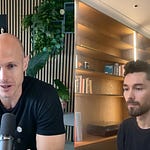In this episode of our "Behind European Unicorns" series, David Cruz e Silva talks with Dan Vahdat, the founder and CEO of Huma, to unpack the journey behind one of Europe’s standout digital health scale-ups. Founded in 2011, Huma is headquartered in London and has grown to approximately 500 employees, raising over €275 million to date.
Dan shares how the company evolved from supporting rare diseases to building a disease-agnostic, globally scalable platform used by healthcare systems, research institutions, and pharmaceutical giants.
Here’s what’s covered:
07:09 The Evolution of Huma
09:56 Challenges and Future Vision
22:16 The Challenges of Starting a Digital Health Company
22:40 Geographical Focus and Strategy
29:57 Navigating Regulatory Challenges in Digital Health
36:12 Partnerships and Organizational Growth
41:26 Future Vision and Expansion Plans for Huma
Watch it here or add it to your episodes on Apple or Spotify 🎧, with chapters for easy navigation available on the Spotify/Apple episode.
Berlin is the place. GITEX is the moment.
Europe’s largest inaugural tech, startup, and digital investment event lands in Berlin. GITEX EUROPE unites global innovators, investors, and policymakers to shape the continent’s future across AI, quantum, cybersecurity, and beyond.
Get a ticket with the EUVC Discount Code - GE25EUVCTKT
✍️ Show notes
The Story Behind The Idea
Dan Vahdat was inspired to launch Huma while pursuing his PhD at Johns Hopkins and growing up in a family of physicians. He noticed a recurring issue in hospitals: while healthcare teams had extensive knowledge about patients during hospital stays, they lost virtually all visibility once patients were discharged. This gap became the focal point of Huma’s mission to maintain insight into patients’ health beyond the clinical setting using digital tools and wearable technology.
The early version of Huma focused on rare diseases, a strategic choice based on the manageable patient population and critical need for remote monitoring in these areas. Dan believed that, over time, technological advancements, such as improved sensors, broader smartphone adoption, and stronger connectivity, would enable the platform to support a wider range of conditions globally. This early vision aligned with broader trends in digital health and laid the groundwork for today’s scalable, disease-agnostic Huma Cloud.
Huma’s Mission
Huma’s mission is to democratize access to quality healthcare through technology, ensuring that both patients in top-tier cities and those in underserved regions benefit equally. Dan likens this vision to the universal accessibility of Google Maps—an example of how digital tools can serve billions across different socioeconomic backgrounds. Huma is already impacting more than 55 million individuals globally, a number he updates manually on his hoodie and coffee mug to reflect real-time reach.
The company is committed to global scalability, focusing on key regions such as the U.S., the U.K., and Germany. While they have piloted initiatives in countries like China and India, Huma’s approach is often geographically specific, with units focusing on one disease in a particular region. In pharma partnerships, however, Huma can deploy across 10 to 40 countries, depending on the use case, especially in clinical trials. These collaborations have helped Huma establish its presence internationally while refining its regulatory and deployment frameworks.
The Business Model: “Cat, Not Lion”
Dan uses a memorable analogy to explain Huma’s structure: “A lion chasing a mouse will die of hunger,” but for a cat, that same mouse is sufficient sustenance. Huma is built on the “cat model,” comprising many smaller units, each profitable on its own, rather than a single monolithic entity. Each unit is led by a “Field CEO” responsible for a specific use case and market, with shared access to company resources and the core platform.
Currently, Huma has around 16–17 Field CEOs, and the ambition is to scale that number significantly to reach the company’s $9 billion ARR goal. Each Field CEO is accountable for driving their unit’s growth, often within a single U.S. state or European country. The model supports lean operations, decentralizes decision-making, and minimizes bureaucracy, which he believes is crucial in navigating the complexity and regulatory hurdles of healthcare.
Scaling to $9B ARR
To reach its goal of $9 billion in annual recurring revenue (ARR), Huma is focused on horizontal scaling by replicating successful use cases across different geographies. Each Field CEO is expected to build a $5–15 million ARR unit, and by launching hundreds of such units, the company aims to compound its growth. Dan emphasizes that it’s not about finding one giant product-market fit but replicating proven models efficiently with the support of the Huma Cloud Platform.
The scalability of this model is made possible by drastically reduced costs in building digital solutions. What once cost tens of millions of dollars and took years now costs as little as $100,000 and can be developed in just weeks. This has turned previously unprofitable segments into viable businesses. However, the biggest bottleneck is talent—finding entrepreneurial Field CEOs who can manage these units independently, navigate regulatory complexity, and drive sales with lean teams.
Lessons from the Fundraising Journey
Huma, like many startups, was affected by the hyper-growth expectations that prevailed during the 2020–2021 venture capital boom. Although the company experienced early success, such as signing national contracts in Germany, Dan admits they made the same mistake as others by over-hiring, inflating their burn rate, and banking on continued rapid growth. When that growth stalled, Huma faced serious risks and had to reassess its model.
The turning point came when they embraced a return to fundamentals: lower operating costs, leaner teams, and sustainable growth. Dan emphasizes a critical piece of advice from a board member: success isn’t just about revenue but about how efficiently that revenue is earned. Since making this shift, Huma has become profitable, reduced unnecessary spending, and focused on building a more resilient, focused organization.
The Role of AI
Artificial intelligence has played a key role in Huma’s evolution, especially in addressing operational inefficiencies in healthcare. Dan highlighted that AI can enable nurses to care for significantly more patients without increasing their workload by automating repetitive tasks, such as data entry, monitoring, and scheduling interventions. This increased productivity is crucial given the global shortage of healthcare workers.
The introduction of AI also opened Dan’s eyes to the true scale of the opportunity. Unlike advertising, which powers companies like Google and Meta and is worth around $1 trillion globally, the healthcare industry is a $10 trillion sector, with half of its expenditures dedicated to human labor. He sees automation and AI not just as cost-saving tools but as the foundation for building one of the most impactful companies in the world.
Some things are made for platforms - music, cabs & pizzas. But fund solutions aren’t one of them. Their individual client focus and regulation-first approach is your guarantee for flexible solutions accommodative to a broad range of deal and client specifics. The kicker? Prices that match any of the shelf-products in the market.
🤗 Join the EUVC Community
Looking for niche, high-quality experiences that prioritize depth over breadth? Consider joining our community focused on delivering content tailored to the experienced VC. Here’s what you can look forward to as a member:
Exclusive Access & Discounts: Priority access to masterclasses with leading GPs & LPs, available on a first-come, first-served basis.
On-Demand Content: A platform with sessions you can access anytime, anywhere, complete with presentations, templates, and other resources.
Interactive AMAs: Engage directly with top GPs and LPs in exclusive small group sessions — entirely free for community members.
💬 Community event | LP AMA with James Heath | ⏰ May 19, 1:00 PM - 2:00 PM GMT+2 | 💻 Online
Ever wonder how LPs actually think about fund strategies, especially in a world leaning toward specialisation? Join our next members-only LP AMA with James Heath, Investment Principal at dara5 and author of Why Specialists Will Win the Next Decade of Venture.
This is a small-group, interactive session where you’ll get the chance to ask candid questions and hear James’s unfiltered take on where LPs are placing their bets—and why.
Why attend?
Hear directly from a leading LP who’s investing in both specialist and generalist VC funds across Europe
Learn how LPs evaluate fund strategies—and why some are doubling down on focused, high-conviction theses
Get a behind-the-scenes look at what’s working in European VC, what’s not, and what LPs are watching next
Available for Members Only, become a member by upgrading to a paid subscription below
Join us at the EUVC Summit & Awards Show

🗓️ The VC Conferences You Can’t Miss
There are some events that just have to be on the calendar. Here’s our list, hit us up if you’re going, we’d love to meet!
0100 Emerging Europe 2025 | 📆 14-16 May 2025 | 🇭🇺 Budapest, Hungary
GITEX Europe 2025 | 📆 23 - 25 May 2025 | 🇩🇪 Berlin, Germany














